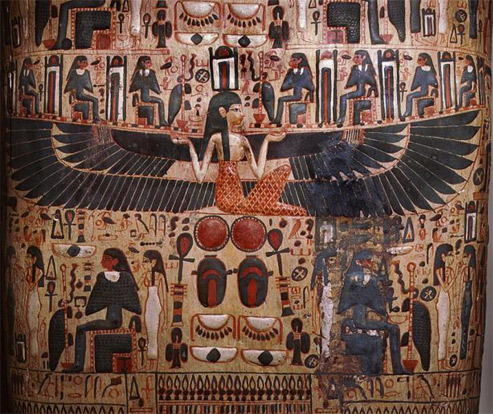Ancient Psychedelia: Alien Gods & Mushroom Goddesses
Online Book - Chapter 10, Page 168
Back to Online Book Mainpage / Next Page (Chapter 10, Page 169)
| In Egyptian mythology, it was said that stars in space were born from the sky-goddess. (89) Nun was the male counterpart to Nut or Nekhbet, the “Lady of Heaven” and “Mistress of the Two Lands” on earth and proprietress of the Dead in the underworld. (90) She was depicted with cow’s horns and often with stars on her body and legs. (91) Her name Nwt means “sky.” (Nut, Net or Nit and known as Maat or Mut) was the primary vulture goddess of Upper Egypt in the Predynastic and early Dynastic Period. (92) In several depictions we saw Nekhbet feeding the Ankh to someone as if it’s food (31a, b). Mut held the crown of a united Upper and Lower Egypt and her colors were red and blue, the two primary colors of the psychedelic mushrooms, A. muscaria and psilocybin. As stated earlier, Nekhbet, being a vulture goddess, would be the cap of the mushroom. The very idea of the vulture associated with the ancient goddess is one of the themes of the Keres. On a painted wood coffin from the 22nd or 23rd Dynasty we see the mushroom pose on two seated figures under the wings of Nut (97f). The Owl was the hieroglyph symbol for death in Egyptian writing. The owl has always been considered a sacred animal and bird. It has vision that exceeds just about every animal and it lives and hunts in the dark. In the occult world this translates to the ability to see clearly through the darkness. The owl is extremely wise and is credited with insightfulness. (93)  (97f) Painted wood from a coffin depicting the goddess Nut spreading her wings in protection over the deceased New Kingdom, 21st or 22nd Dynasty Nephthys was the daughter of Geb and Nut and the sister of Osiris, Isis and Horus and the sister and wife of Set. She was referenced in texts dating back to the Old Kingdom. Her name is said to mean “Mistress of the House.” She was a goddess of the air and sky and could take the form of a bird, specifically, a vulture and as a result she became a goddess of death and mourning. Her worshipers who mourned professionally, were knows as “Hawks of Nephthys” and as such she was also associated with the hawk as a bird, likely due to the fact that the hawk is another “bird of prey” like the vulture. (94)(95) |
Anuqet (also known as Anket, Anqet, Anjet or Anukis) was an ancient Egyptian goddess of the Nile and known as the “nourisher of the fields.” She was also a goddess of the wild animals and childbirth. She was a “giver of life, and of all health, and of all joy of the heart.” (96) She was worshiped in Nubia and given the title “Mistress of Nubia.” She was considered the wife of Amun, in southern Nubia when Khnum merged with Amun. (97) However, several other goddesses shared this title, and we must remember the mythology and heredity of the gods was not an exact science. It morphed strategically over time, depending on the motives and spirit of the nation it served. (96) Anuqet was equated with Nephthys (Nepthet) and in Greece, with Hestia. (98) Hathor was the most popular cow goddess and mother of Horus the Elder. E.O. James, citing Wiedemann, writes that: “all goddesses were attributes of Hathor according to the priests of Denderah.” (99) One of Hathor’s epithets was “Lady of the Turquoise.” Turquoise mines were prevalent around Egypt in 1500 BC. Hathor was called the “Mother of the World” and “Creator of the Heavens” of the earth, and everything in them. She was either represented as a cow or as a cow with a human body and a cow’s head and was often depicted with the round disc or globe between her horns. (100) She was also known as “The Great One of Many Names.” Hathor may in fact be related to Bast, a cow-goddess of pre-Dynastic times who represented the Milky Way. The whole reason we call it the “Milky Way” is because of the origin of the world and even the sky and galaxy, from the cow goddess. She appears in the Old Kingdom with Bast at the valley temple of Khafre at Giza where Hathor represents Upper Egypt and Bast represents Lower Egypt. Hathor has similarities to Nut as a sky goddess and was ultimately merged with Isis who became the most popular goddess of Egypt. (101) (89) Mythology and Symbols, p. 38; PH. Derchain "Mythes et Dieux Lunaires en Egypte". In Sources Orientales. ed.du Seuil. Paris. 1962., p. 27 (90) Pyramid Text, 580, 827f; Budge, The Book of the Dead, p. 59 (91) Cult of the Mother Goddess, p. 58-59 (92) http://prizedwriting.ucdavis.edu/love-and-loathing-role-vulture-three-cultures (93) Language of the Goddess, p. 190 (94) Healing Gods, p. 53 (95)https://www.ancientegyptonline.co.uk/nephthys.html (96) Healing Gods, p. 53; Budge, Gods, ii, 57-58 (97)https://www.ancientegyptonline.co.uk/anuket.html (98) Healing Gods, p. 53; Muller, Mythology, Egyptian, p. 131 (99) Cult of the Mother Goddess, p. 59; Religion of the Ancient Egyptians, 1897, p. 143 (100) Healing Gods, p. 58; Budge, I, 428-438, 467 (101) https://www.ancientegyptonline.co.uk/hathor.html |
Go Back to Page 167